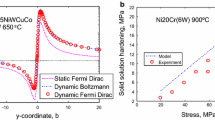Abstract
The elevated-temperature creep behavior of Type 304 stainless steel is examined in terms of the measured effective and internal stresses. Results show that the mean effective stress is related to the applied stress by a power law of the form σ* = α(σ)β, where the constants α and β are functions of temperature. The dependence of creep rate on applied stress follows a power law, and the stress exponent is dependent on temperature. The latter behavior arises from the variation in the mean effective stress with applied stress and temperature. The creep rates are also described as a function of effective stress. The dislocation velocity-stress exponent obtained from stresschange tests is higher than the effective stress exponent evaluated from creep data. The dependence of creep rate on temperature at various values of effective stress yields a total activation energy of approximately the same magnitude as self-diffusion.
Similar content being viewed by others
References
A. H. Cottrell and V. Aytekin:J. Inst. Metals, 1950, vol. 77, pp. 389.
J. Weertman:J. Appl. Phys. 1957, vol. 28, p. 362.
D. McLean:Rep. Progr. Phys., 1966, vol. 29, p. 1.
S. K. Mitra and D. McLean:Metal Sci. J., 1967, vol. 1, p. 192.
R. Lagneborg:Proc. Conf. on Creep and Fracture of Metals at High Temperaturature, p. 21, M.M.S.O., 1956.
P. B. Hirsch and D. H. Warrington:Phil. Mag., 1961, vol. 6, p. 735.
C. R. Barrett and W. D. Nix:Acta Met., 1965, vol. 13, p. 1247.
G. B. Gibbs:Phil. Mag., 1971, vol. 23, p. 771.
W. D. Nix and C. R. Barrett:Trans. ASM, 1968, vol. 61, p. 695.
A. A. Solomon and W. D. Nix:Acta Met., 1970, vol. 18, p. 863.
L. J. Cuddy:Met. Trans., 1970, vol. 1, p. 395.
F. Garofalo, O. Richmond, W. F. Domis, and F. Von Gemmingen:Joint International Conf. on Creep, p. 1, The Institute of Mechanical Engineers, London, 1963.
F. Garofalo, W. F. Domis and F. Von Gemmingen,Trans. TMS-AIME, 1964, vol. 230, p. 1460.
C. N. Ahlquist and W. D. Nix,Acta Met., 1971, vol. 19, p. 373.
J. T. Michalak:Acta Met., 1965, vol. 13, p. 213.
R. N. Stevens:Met. Rev., 1966, vol. 11, p. 129.
G. J. Lloyd and R. J. McElroy:Acta Met., 1974, vol. 22, p. 339.
T. B. Gibbons, V. Lupinc, and D. McLean:Metal Sci. J., 1975, vol. 9, p. 437.
J. C. M. Li:Dislocation Dynamics, A. R. Rosenfield, G. T. Hahn, A. L. Bement, and R. I. Jaffe, eds., p. 87. McGraw-Hill, New York, N.Y., 1968.
Author information
Authors and Affiliations
Rights and permissions
About this article
Cite this article
Chopra, O.K., Natesan, K. Interpretation of high-temperature creep of type 304 stainless steel. Metall Trans A 8, 633–638 (1977). https://doi.org/10.1007/BF02676986
Received:
Issue Date:
DOI: https://doi.org/10.1007/BF02676986




